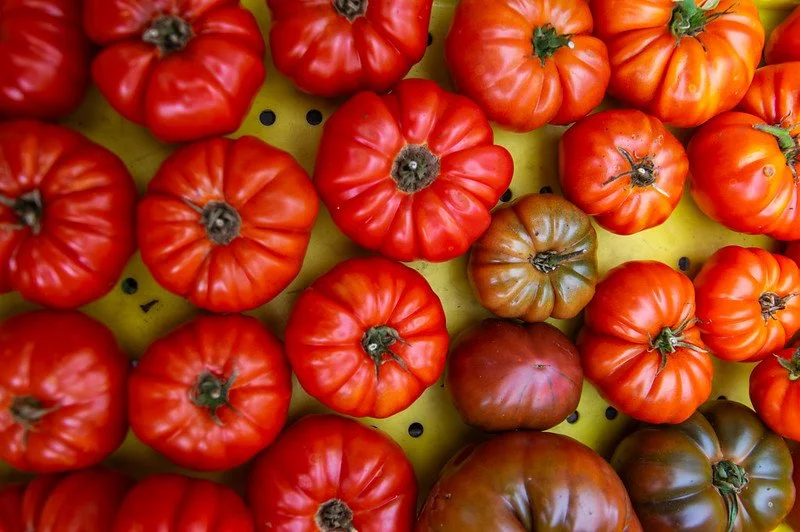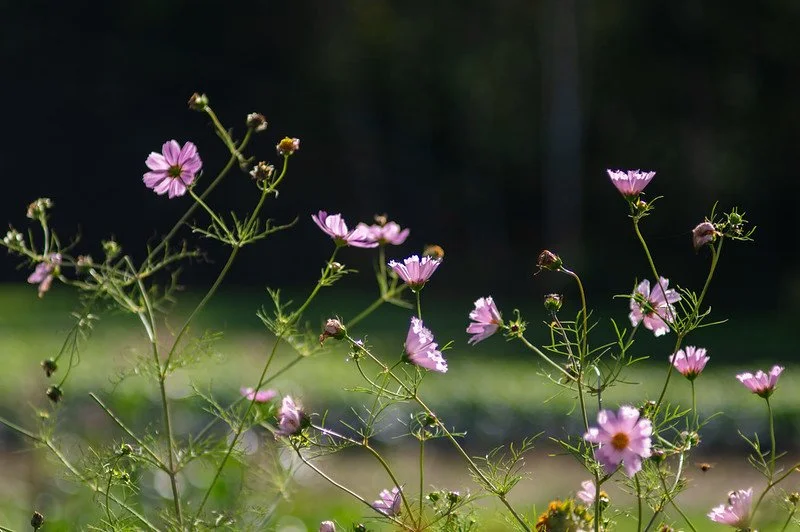17th Week of the Summer CSA season: Week of September 26th
Painted Mountain corn feels unbelievably beautiful… like every ear is an individual work of art. These particular ears aren’t even the most stunning ones we have found… We have been selecting overtime for the marbled kernels, as well as some of the fuchsia, pink, and purple ones, and this year we have been seeing a lot more of all of that. I sometimes make a pink cornbread with a pureed beet for the coloring (and nutrition!) that our kids love, but now I think I will try a pink cornbread just from the brightest pink kernels. This particular variety was bred in the 1970s by a Montana grower who was selecting for hardiness, flavor, storage, drought-tolerance, and beauty by cross pollinating various heirlooms varieties grown for centuries by Indigenous Americans and more recently by colonial settlers. Photo by Adam Ford
CSA Balance Due
If you haven’t already paid, your balance is due. You can pay online through your account (with a card or e-check ACH payment), mail a check to Evening Song Farm 48 Nice Road, Cuttingsville VT 05738, leave a check or cash in the CSA cash box at the barn, send money with Venmo @eveningsongcsa, or use EBT. It’s very cool to pay in smaller chunks, just let us know what your payment plan is.
these beets are also as beautiful as they are delicious, photo by Adam Ford
carrots are back! after losing some mid-season planting to saturated July soils, photo by Adam Ford
This Week’s Availability
This week we will have yellow beets, red beets, yellow potatoes, red potatoes, mesclun mix, green napa cabbage, broccoli, pea shoots, green beans, parsley, scallions, baby lettuce, spinach, arugula, baby bok choi, green curly kale bunches, lacinato kale bunches, garlic, husk cherries, Carmen sweet red peppers, green sweet Carmen peppers, poblano peppers, jalapeño peppers, green serrano peppers, mini green snack peppers, green tomatoes, tomatillos, shallots, leeks, carrots, cherry tomatoes, plum tomatoes, heirloom tomatoes, beefsteak tomatoes, Painted Mountain grain corn, and brussels crowns.
*Painted Mountain Grain corn is a gorgeous flour corn that we use to make tortillas and empanadas, or for decorating, and also as beads by drilling holes through the kernels! To use it to cook with, we break the kernels off the cob, nixtamalize it, then grind it. We have a hand crank grain grinder, but we have heard from folks that they have used a food processor to turn the soaked kernels into a flour for tortillas and empanadas. If you are interested in trying it to cook with it and haven’t nixtamalized corn before, here is a fine tutorial. We use wood ash as the calcium hydroxide in that recipe.) If you want to try making corn beads, you can take the smallest drill bit you have, and carefully drill a hole through the center of a corn kernel on the edge of the ear, and then push the drill bit through the line of kernels on the cob, usually drilling 8-10 kernels at a time. Have fun! This is a fun plant because we love how it creates beauty and food in the house. If you are decorating with the corn, keep it inside… when folks have tried to decorate outside, critters eat it overnight!
If you do any bulk preserving, now is a great time to snag jalapenos (or serranos, both $6/pound) or if you use any for fermenting, hot sauce, pickled jalapenos, jalapeno jelly, or whatever! We have 8- and 10-pound bags of frozen elderberries available (as well as a couple random-sized small bags, elderberries are $10/pound), and if you are inspired to preserve any sweet red or green Carmen peppers ($3/pound) for the winter, now is a good time for that as well. (We slice and freeze them, dry them, and roast and puree them into a sauce for the freezer.) Send us an email if we should put anything aside for you.
Ordering closes at noon on Tuesdays for Wednesday bags, and at midnight on Wednesdays for Friday bags.
You do not need to fill out the form if you plan to come to the barn on Tuesdays, Wednesdays or Thursdays to pick out your items yourself.
green and ripening tomatoes, photo by Adam Ford
green cherry tomatoes we probably won’t get to harvest… photo by Adam Ford
sungolds, photo by Adam Ford
Farm News
This week we continued to transition the tunnels from summer production to winter production. It’s a busy and sad/exciting time. I feel melancholic to pull out producing plants like tomatoes, but then get very eager to plunk in all the robust winter greens transplants.
We are getting the root cellar ready to start getting that space ready for winter storage as we start bulk fall harvests in the coming weeks. It’s also that time of year we keep our eyes on the extended forecast for the potential for a first frost, to make sure we get all our row covers ready to extend certain crops. Next week we hope to get the last of the transplants in the tunnel after we gave one of the tunnels a full week to germinate and kill weed seeds after removing the summer crops.
Ryan hosted a workshop for the Vermont Vegetable and Berry Association last week, with a focus on low- and no-till production methods on a hillside. It was a great turn out, and always invigorating to connect with other farmers around the state. When we started growing on this hillside, we didn’t know what we were doing: how to manage soil with an eye for tiny and big erosional events, how to manage fertility on a slope, how to design tools and implements for sloping production. But we have experimented and collaborated with researchers and tweaked our setup over the past decade+, and it’s kind of neat to see the systems working so well for the particular piece of land we grow on. Between the various groups we are each a part of this season (me= climate change cohort, Ryan= soil building cohort), we have found that the dominant discussion among farmers these days is (of course) farming in a changing climate. So there were fulfilling conversations about how to manage soils and fertility in the face of more frequent dramatic weather, particularly with the use of cover crops within a production system. It’s nice to be reminded that so many of us (growers) are scratching our heads for continually evolving future solutions to these issues, and trade ideas around the challenges we face.
Other things on my mind this week: If you are like me, and you think a lot about how Vermont presents itself as welcoming and celebratory to everyone, this great (short) read about the nuance of a recent ad campaign put out by the VT Agency of Agriculture is a helpful perspective to add to that discussion.
Have a great week,
-ESF Team: Ryan, Kara, Cindy, Galen, Katie, K2, Taylor, Vanessa, Bryan, and Tabita (and Sky and Soraya)
Weekly Recipe
and now for a rainbow tour of tomatoes, starting with green, photo by Adam Ford
Orange! photo by Adam Ford
Red! photo by Adam Ford
yellow tomatoes! low acid, sweet, one of my favorites, photo by Adam Ford
orange and red stripey! (solar flare) photo by Adam Ford
Purple! photo by Adam Ford
this cabbage is attempting a rainbow on its own, with the dying outer leaf, photo by Adam Ford
green curly kale… our kids’ favorite way to eat this is fresh in the field, like goats, photo by Adam Ford
flowers seem to provide endless rainbows, photo by Adam Ford
healed over spots on the stem where leaves have been harvested all season, photo by Adam Ford
pile of gravel to repair places on our drive alleys that need a little support after the wet, wet summer, photo by Adam Ford
winter salads before transplanting,, photo by Adam Ford
Bryan uses my favorite transplant tool… the humble butter knife: quick stab in the ground is all that’s needed to quickly tuck in a lettuce plant, photo by Adam Ford
scallions, photo by Adam Ford
Cindy putting a tool away, photo by Adam Ford
rows of Painted Mountain corn, photo by Adam Ford
cosmos still putting out blooms as the flower garden winds down, photo by Adam Ford
wild turkeys lurking around the end of the fields waiting to scratch up and eat all our recently seeded cover crop seeds…. no thanks, turkeys, photo by Adam Ford
Ryan and Cindy drove around doing spot repairs that day wherever it was needed, photo by Adam Ford
winter salads after transplanting, photo by Adam Ford
Bryan, Taylor, and K2 transplanting baby lettuce… it’s always a surprise to me that these are ready for harvest during the end of the fall CSA season! photo by Adam Ford
red Napa cabbage, photo by Adam Ford
garlic trimmers, photo by Adam Ford
morning glory! photo by Adam Ford
potentially the last cherry tomato harvest of the year, photo by Adam Ford
Vanessa made everyone stunning marigold necklaces for the Shrewsbury Day parade last weekend (while Sky and his trumpet ate husk cherries), photo by Ryan
































